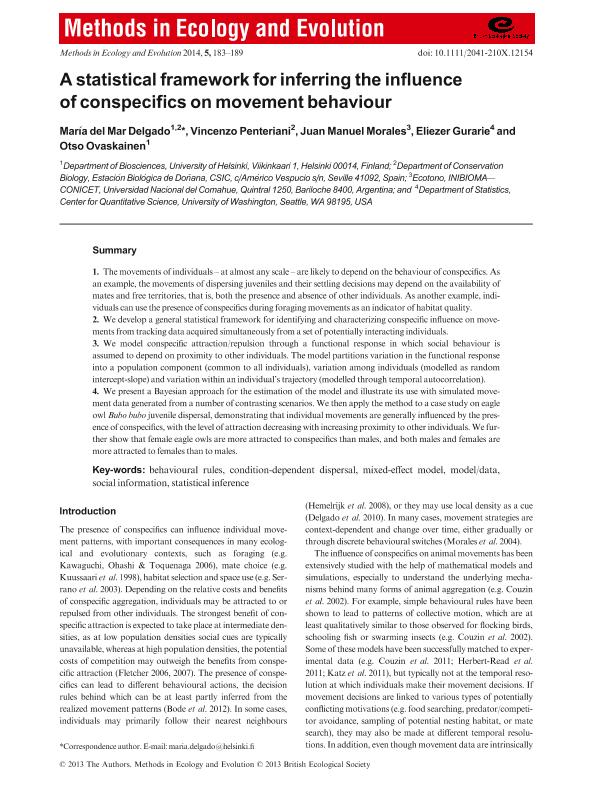Mostrar el registro sencillo del ítem
dc.contributor.author
Delgado, María del Mar
dc.contributor.author
Penteriani, Vincenzo
dc.contributor.author
Morales, Juan Manuel

dc.contributor.author
Gurarie, Eliezer
dc.contributor.author
Ovaskainen, Otso
dc.date.available
2017-01-24T18:02:47Z
dc.date.issued
2014-02
dc.identifier.citation
Delgado, María del Mar; Penteriani, Vincenzo; Morales, Juan Manuel; Gurarie, Eliezer; Ovaskainen, Otso; A statistical framework for inferring the influence of conspecifics on movement behaviour; Wiley; Methods in Ecology and Evolution; 5; 2; 2-2014; 183-189
dc.identifier.issn
2041-210X
dc.identifier.uri
http://hdl.handle.net/11336/11817
dc.description.abstract
The movements of individuals – at almost any scale – are likely to depend on the behaviour of conspecifics. As an example, the movements of dispersing juveniles and their settling decisions may depend on the availability of mates and free territories, that is, both the presence and absence of other individuals. As another example, individuals can use the presence of conspecifics during foraging movements as an indicator of habitat quality.
We develop a general statistical framework for identifying and characterizing conspecific influence on movements from tracking data acquired simultaneously from a set of potentially interacting individuals.
We model conspecific attraction/repulsion through a functional response in which social behaviour is assumed to depend on proximity to other individuals. The model partitions variation in the functional response into a population component (common to all individuals), variation among individuals (modelled as random intercept-slope) and variation within an individual's trajectory (modelled through temporal autocorrelation).
We present a Bayesian approach for the estimation of the model and illustrate its use with simulated movement data generated from a number of contrasting scenarios. We then apply the method to a case study on eagle owl Bubo bubo juvenile dispersal, demonstrating that individual movements are generally influenced by the presence of conspecifics, with the level of attraction decreasing with increasing proximity to other individuals. We further show that female eagle owls are more attracted to conspecifics than males, and both males and females are more attracted to females than to males.
dc.format
application/pdf
dc.language.iso
eng
dc.publisher
Wiley

dc.rights
info:eu-repo/semantics/openAccess
dc.rights.uri
https://creativecommons.org/licenses/by-nc-sa/2.5/ar/
dc.subject
Behavioural Rules
dc.subject
Condition-Dependent Dispersal
dc.subject
Mixed-Effects Model
dc.subject
Social Information
dc.subject.classification
Ecología

dc.subject.classification
Ciencias Biológicas

dc.subject.classification
CIENCIAS NATURALES Y EXACTAS

dc.title
A statistical framework for inferring the influence of conspecifics on movement behaviour
dc.type
info:eu-repo/semantics/article
dc.type
info:ar-repo/semantics/artículo
dc.type
info:eu-repo/semantics/publishedVersion
dc.date.updated
2016-12-12T14:21:11Z
dc.journal.volume
5
dc.journal.number
2
dc.journal.pagination
183-189
dc.journal.pais
Reino Unido

dc.journal.ciudad
Londres
dc.description.fil
Fil: Delgado, María del Mar. University Of Helsinki; Finlandia. Consejo Superior de Investigaciones Cientificas. Estacion Biologica de Doñana; España
dc.description.fil
Fil: Penteriani, Vincenzo. Consejo Superior de Investigaciones Cientificas. Estacion Biologica de Doñana; España
dc.description.fil
Fil: Morales, Juan Manuel. Universidad Nacional del Comahue. Centro Regional Universitario Bariloche. Laboratorio de Ecotono; Argentina. Consejo Nacional de Investigaciones Científicas y Técnicas. Centro Científico Tecnológico Patagonia Norte. Instituto de Investigación en Biodiversidad y Medioambiente; Argentina
dc.description.fil
Fil: Gurarie, Eliezer. University Of Washington; Estados Unidos
dc.description.fil
Fil: Ovaskainen, Otso. University Of Helsinki; Finlandia
dc.journal.title
Methods in Ecology and Evolution
dc.relation.alternativeid
info:eu-repo/semantics/altIdentifier/url/http://onlinelibrary.wiley.com/doi/10.1111/2041-210X.12154/abstract
dc.relation.alternativeid
info:eu-repo/semantics/altIdentifier/doi/http://dx.doi.org/10.1111/2041-210X.12154
Archivos asociados
